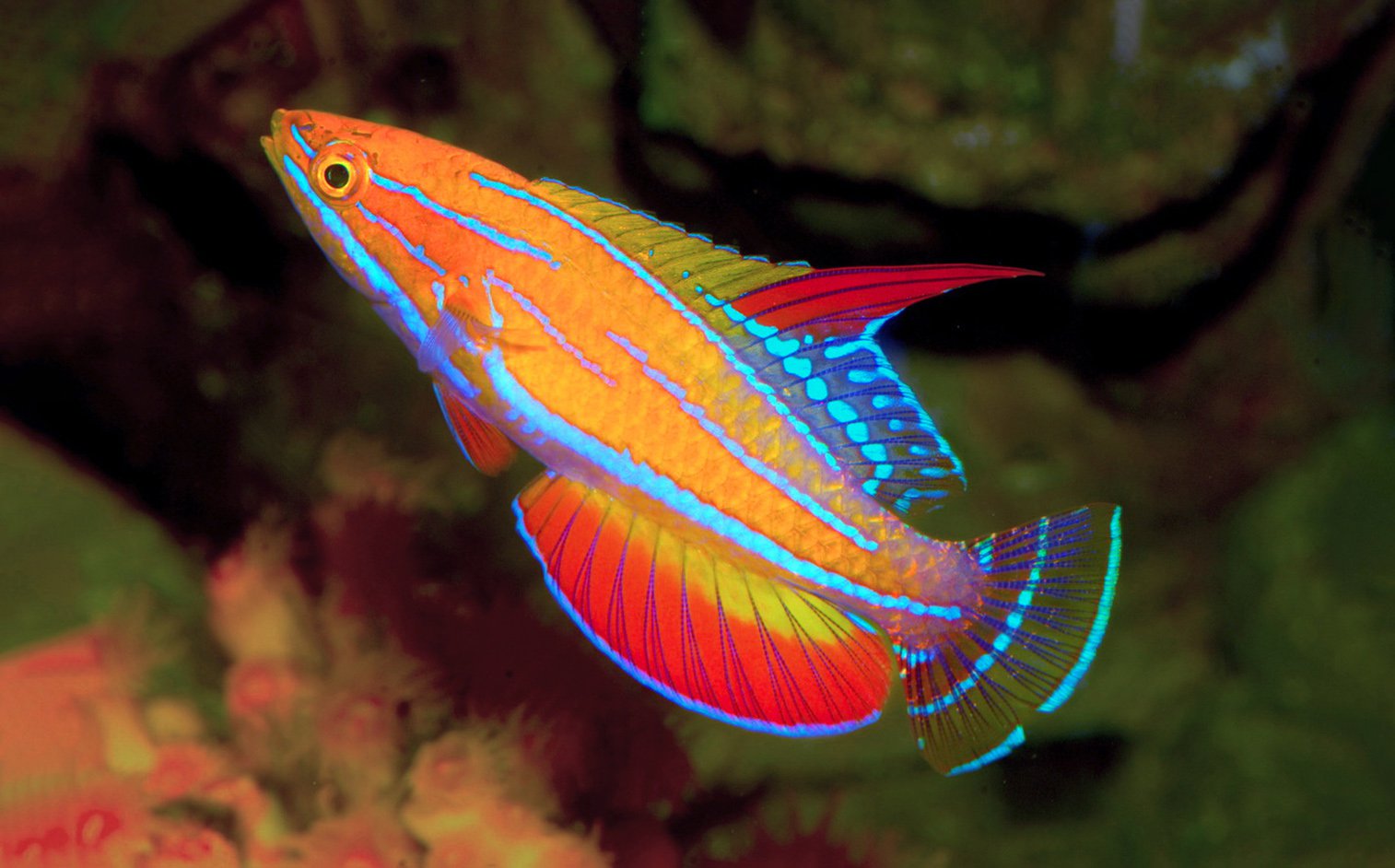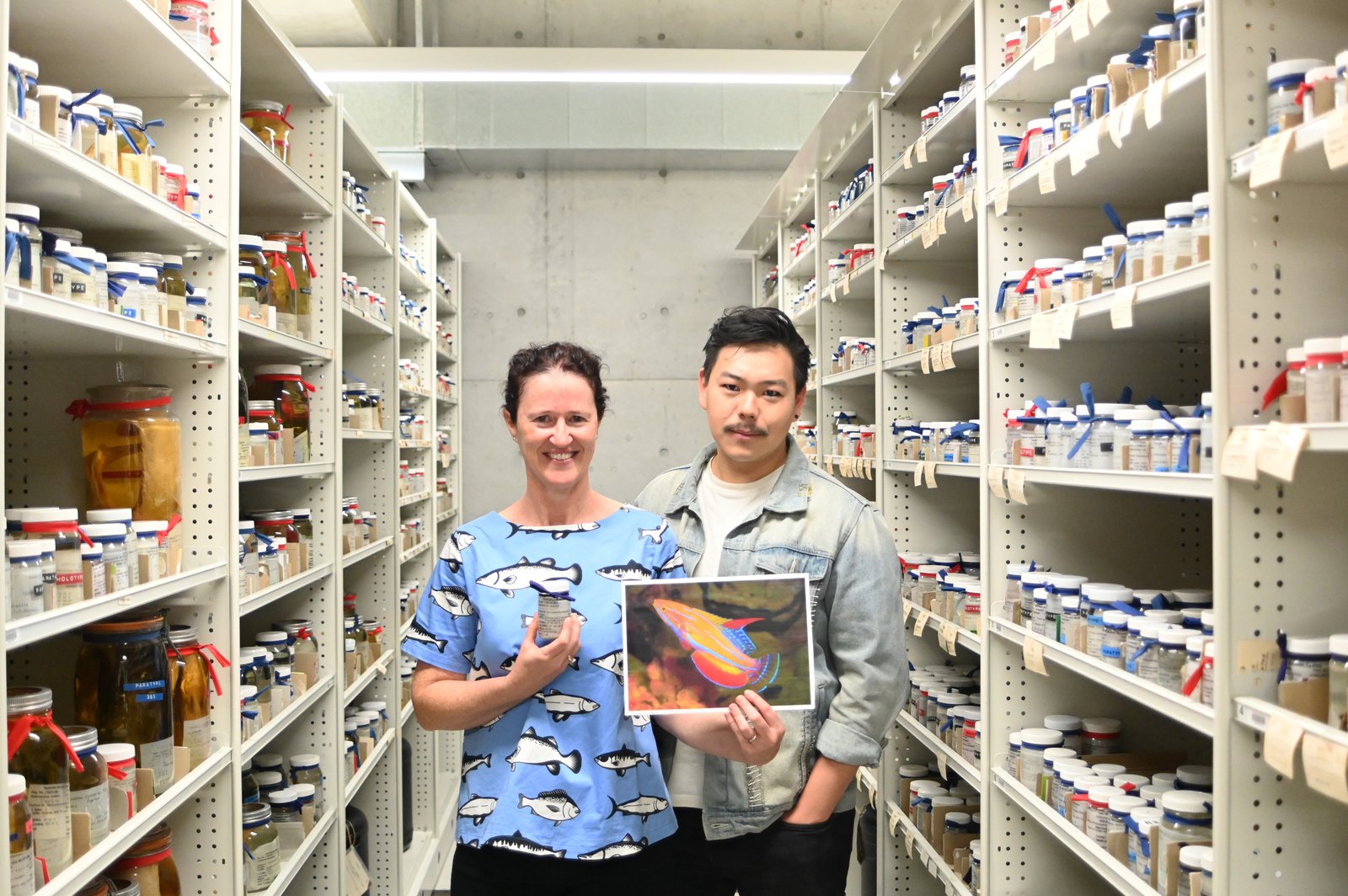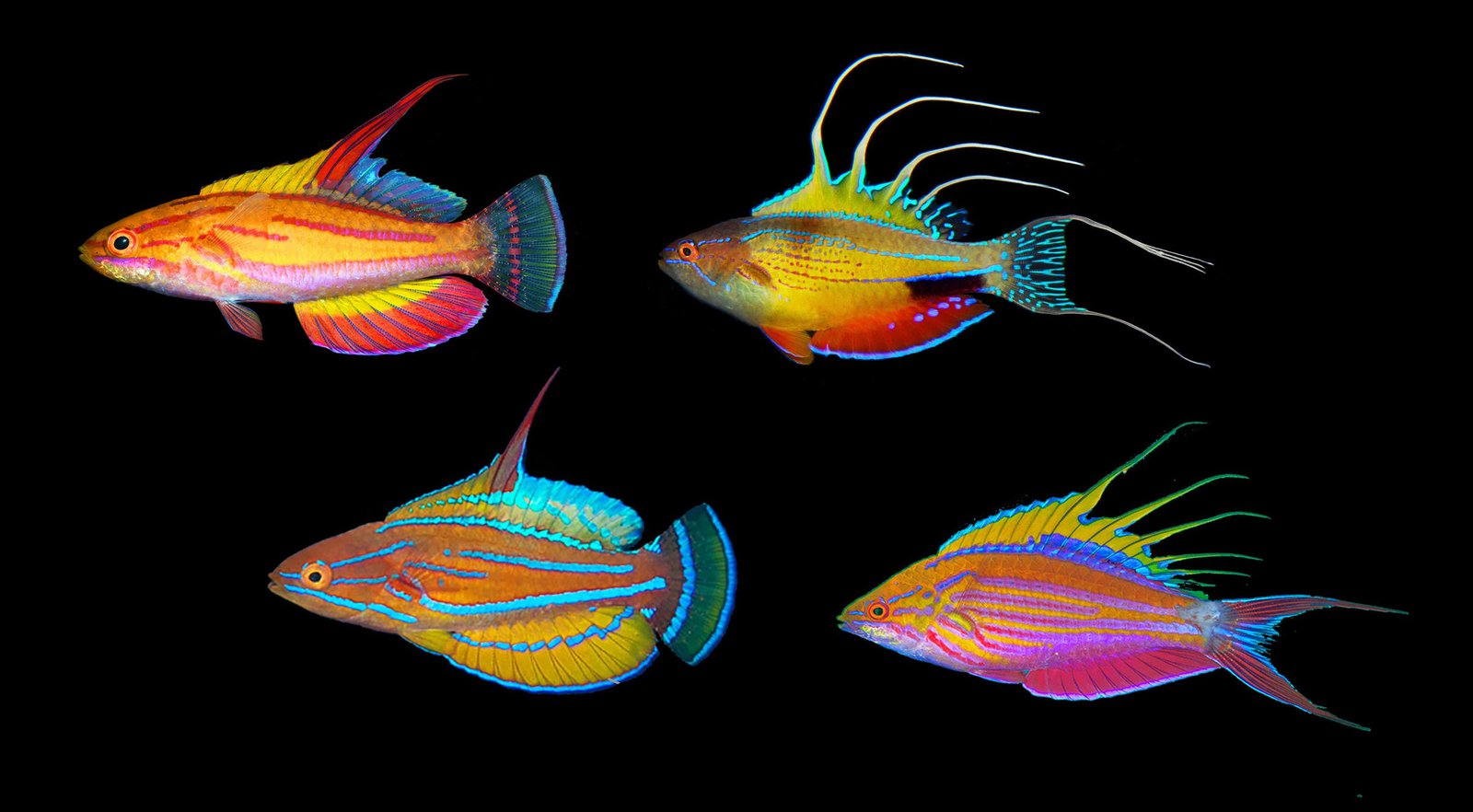Australia’s dazzling flasher wrasses!
Flasher wrasses are a group of dazzling, colourful little fishes. Of the twenty or so species found globally, three are known to occur in Australia – or so we thought! A new study re-examines this group, and includes a species new to science, named after an Australian Museum superstar.
The flasher wrasse genus Paracheilinus include some of the most spectacular fishes to be found on coral reefs, most notable for their captivating colours and stunning courtship displays. They are small, brightly coloured fishes, many of which have ornamented fins adorned with trailing filaments. Their true beauty however is best appreciated several hours before sunset, where males erupt in dizzying acts of courtship that includes rapid swimming, fin flaring, and displays of iridescent neon colours. However, there are a number of taxonomic problems that plague this iconic group – which a new publication, co-authored by the Australian Museum’s Dr Yi-Kai Tea, attempts to rectify.
The flasher wrasses attain their highest diversity in the Coral Triangle, with 13 of the 20 known species occurring there. Despite Australia’s northern half abutting the Coral Triangle, the distribution and occurrence of flasher wrasses in Australia and its remote territories are not well understood. Based on previous surveys of Australian coral reefs, three species of flasher wrasses have been reported as extant – they are: Paracheilinus filamentosus, the Filamented Flasher Wrasse, Paracheilinus flavianalis, the Yellowtail Flasher Wrasse, and Paracheilinus rubricaudalis, the Redtail Flasher Wrasse. Paracheilinus flavianalis was described from specimens collected off northwestern Australia but the status of the remaining two species in Australia has been doubtful.

Paracheilinus amanda, Amanda’s Flasher Wrasse.
Image: Kiyoshi Endoh.© Image adapted from Tea & Walsh, 2023, Ichthyology & Herpetology.
An in-depth survey of the literature and examination of specimens in all state museums in Australia however revealed a surprising state of affairs – that we know very little about these incredible fishes living right under our noses! There were several issues that needed rectifying here, the first of which was the identity of P. rubricaudalis, the Redtail Flasher Wrasse. This species is known primarily from Melanesia, including Papua New Guinea, the Solomon Islands, Fiji, and Vanuatu. In Australia, it has been reported from the Coral Sea and the northern Great Barrier Reef. Examination of museum specimens and photographic records reveal that the Australian population represents a highly distinct and geographically isolated species different from the “true” P. rubricaudalis. To solve this first problem required describing the Australian population as a new species, which we named Paracheilinus amanda, Amanda’s Flasher Wrasse.
The new species honours Amanda Hay, Collection Manager of the Ichthyology collection at the Australian Museum. Amanda’s 25 years of experience in ichthyological collections and research has not only contributed significantly towards the study of Australasian fishes, but also supported and assisted the research endeavours of so many ichthyologists of all career stages working at the Australian Museum. Congratulations Amanda!

© Australian Museum
The second issue concerned P. filamentosus, the Filamented Flasher Wrasse. Pull out any field guide of fishes of the Great Barrier Reef and this species is bound to be depicted. Yet, no verifiable Australian records of this species exist. Is this fish a myth? A story of he said, she said? Turns out, Australian records of this species are a result of anecdotal accounts perpetuated in the literature. A deep dive into our collections revealed a single specimen of the Filamented Flasher Wrasse collected from Lizard Island in 2001. The specimen was collected by Jeff Leis and Amanda Hay, and for 22 years it sat on the shelves untouched and unnoticed, until this year, where it serves as the only proof of this species existence in Australia. How did the existence of the Filamented Flasher Wrasse in Australia come to be then? We’ll never know the beginning, but at least we now have an end – 22 years in the making!

© Image adapted from Tea & Walsh, 2023, Ichthyology & Herpetology.

© Image adapted from Tea & Walsh, 2023, Ichthyology & Herpetology.
While looking at flasher wrasse specimens across Australia, one specimen stood out as being different. The specimen, housed in the Museum and Art Gallery of the Northern Territory (MAGNT), did not agree with any of the known species of flasher wrasses in Australia. It was a specimen of Paracheilinus nursalim, Nursalim’s Flasher Wrasse, an exceptionally stunning species previously known only from the Bird’s Head Peninsula region of West Papua. But, West Papua is some 1,200 km away. Fortunately, the Australian Museum has two paratypes of P. nursalim for comparison. In addition to some underwater photographs taken by local divers, the identity of the Northern Territory specimen was confirmed to be P. nursalim, the fourth species of flasher wrasse extant in Australia.

© Image adapted from Tea & Walsh, 2023, Ichthyology & Herpetology.
This research highlights the importance of museum collections and methodical sampling. Even specimens collected 22 years ago from reefs so heavily studied like Lizard Island can have their day in the sun, helping shed light on our understanding of Australia’s coral reefs. If the most colourful and iconic of coral reef fishes can go unnoticed, imagine the biodiversity crisis affecting some of the less noticeable species.

© Heok-Hui Tan, Kazuhiko Nishiyama, Kevin Kohen, and Mark Rosenstein.
Dr Yi-Kai Tea, Chadwick Biodiversity Research Fellow, Ichthyology, Australian Museum.
More information:
- Tea, YK. and Walsh, F. 2023. Review of Australian species of Paracheilinus Fourmanoir (Teleostei: Labridae) with description of a new species from the Great Barrier Reef and Coral Sea. Ichthyology & Herpetology, 111(3), 397-415. https://doi.org/10.1643/i2023019
Acknowledgements:
This research was supported by the Chadwick Biodiversity Research Fellowship, which was awarded to Dr Yi-Kai Tea in 2022. Established in 2008 with thanks to a generous bequest from the late Clarence E. Chadwick, the Chadwick Biodiversity Research Fellowship provides opportunity for gifted young scientists to establish a career in biodiversity research.











